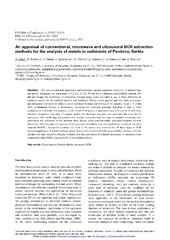Приказ основних података о документу
An appraisal of conventional, microwave and ultrasound BCR extraction methods for the analysis of metals in sediments of Pancevo, Serbia
| dc.creator | Relić, Dubravka | |
| dc.creator | Đorđević, Dragana S. | |
| dc.creator | Sakan, Sanja M. | |
| dc.creator | Anđelković, Ivan | |
| dc.creator | Pantelić, A. | |
| dc.creator | Stanković, R. | |
| dc.creator | Radoičić, Aleksandra | |
| dc.creator | Popović, Aleksandar R. | |
| dc.date.accessioned | 2018-11-22T00:24:25Z | |
| dc.date.available | 2018-11-22T00:24:25Z | |
| dc.date.issued | 2013 | |
| dc.identifier.issn | 2267-1242 | |
| dc.identifier.uri | https://cherry.chem.bg.ac.rs/handle/123456789/1429 | |
| dc.description.abstract | We use conventional, microwave and ultrasound assisted sequential extraction, of defined time and power, techniques for extractions of Cd, Cu, Cr, Ni, Pb and Zn in sediments and certified material. We did not change the conditions of extractions through steps, cause we what to see is there difference in extraction results for the certified material and sediments. We use lower powers and time from microwave and ultrasound extraction in order to avoid additional heating and boiling of the samples. Steps 1-3 of the BCR (Community Bureau of Reference), excluding the hydrogen peroxide digestion in step 3, were completed in 16 h in the conventional, in 120 s with 90 W power of microwave and in 30 min of 42 kHz of an ultrasonic frequency. Digestion of organic matter with hydrogen peroxide was performed the same for all techniques. The fourth step, the pseudo-total content, was performed the same on samples remaining after performing the extraction of the previous three phases either conventionally, microwave-assisted or with ultrasound. The precision and accuracy of the proposed procedures were evaluated using a certified reference material BCR701. Acceptable accuracy for most of the metals was observed for all three steps of BCR protocol applying a 16 h total shaking period. Metals were determined with an acceptable accuracy after the pseudo-total step; expect Cr. Results obtained after the application of different techniques on sediments were comparable with ANOVA test for the 95 % of confidence level. | en |
| dc.publisher | E D P Sciences, Cedex A | |
| dc.relation | info:eu-repo/grantAgreement/MESTD/Basic Research (BR or ON)/172001/RS// | |
| dc.relation | info:eu-repo/grantAgreement/MESTD/Integrated and Interdisciplinary Research (IIR or III)/43007/RS// | |
| dc.rights | openAccess | |
| dc.rights.uri | https://creativecommons.org/licenses/by/4.0/ | |
| dc.source | Proceedings of the 16th International Conference on Heavy Metals in the Environment | |
| dc.subject | Heavy metals | en |
| dc.subject | Danube alluvial sediments | en |
| dc.subject | BCR | en |
| dc.title | An appraisal of conventional, microwave and ultrasound BCR extraction methods for the analysis of metals in sediments of Pancevo, Serbia | en |
| dc.type | conferenceObject | |
| dc.rights.license | BY | |
| dcterms.abstract | Станковић, Р.; Поповић, Aлександар; Радоичић, Aлександра; Aнђелковић, И.; Релић, Дубравка; Ђорђевић, Д.; Сакан, С.; Пантелић, A.; | |
| dc.citation.volume | 1 | |
| dc.identifier.wos | 000326475400299 | |
| dc.identifier.doi | 10.1051/e3sconf/20130139002 | |
| dc.citation.other | 1: - | |
| dc.description.other | PROCEEDINGS OF THE 16TH INTERNATIONAL CONFERENCE ON HEAVY METALS IN THE ENVIRONMENT | |
| dc.description.other | E3S Web of Conferences, Volume 1 | |
| dc.type.version | publishedVersion | en |
| dc.identifier.scopus | 2-s2.0-84996657161 | |
| dc.identifier.fulltext | https://cherry.chem.bg.ac.rs/bitstream/id/6306/e3sconf_ichm13_39002.pdf |


